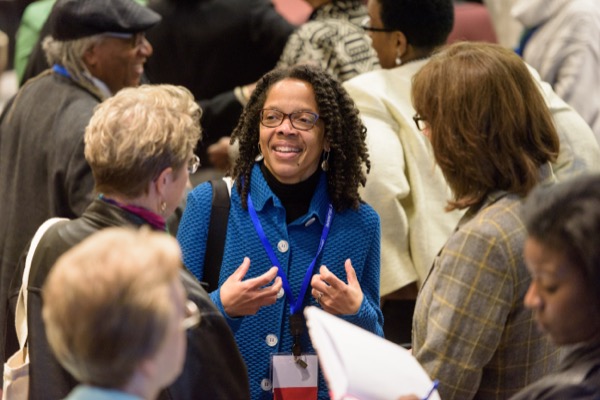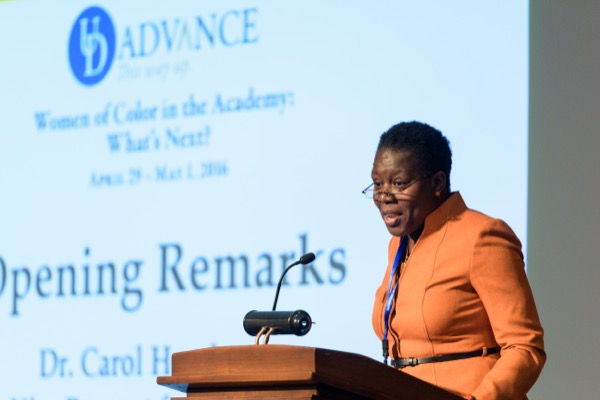


Stories behind the statistics
National conference on women of color underlines need for narratives, context
Editor's note: For full coverage, also see "A call to 'Color the Academy'" and "Toward greater diversity and excellence."
6:16 p.m., May 6, 2016--Statistics don’t lie. But, they rarely tell the whole story.
During the conference “Women of Color in the Academy: What’s Next?” held at the University of Delaware, Gilda Barabino, dean of engineering at the City College of New York, displayed a graph illustrating the number of engineering faculty across 345 colleges and universities.
Campus Stories
From graduates, faculty
Doctoral hooding
“The bars you can barely see are for racial ethnic populations,” she said.
The numbers are even smaller for women.
“The stark underrepresentation … is real,” explained Barabino, who was the keynote speaker at the opening session of the conference held April 29–May 1. The conference, organized by the UD ADVANCE Institute, brought together in a unique way social science researchers and the women of color who are living the experience.
“Mentoring is key to successful career progression, yet what constitutes effective mentoring remains elusive, and women of color are less likely to be mentored. So, what’s missing?” asked Barabino.
“We need effective strategies that are tailored to women of color,” she suggested.
According to Barabino, part of the strategy needs to include telling the stories that make up the numbers in the graph. Narratives can make the difference, and mentoring provides an opportunity to provide context to the numbers.
Sharon Neal, professor of chemistry and biochemistry at UD and one of the program co-chairs for the conference, echoed Barabino’s suggestion to tell the stories behind the statistics. “[Conference organizers] were reading a little about what was in the literature on women of color in academia,” she said, “and one of the studies pointed out there is a lot of counting go on. We know a lot about the numbers. There’s not as much information that gives context to those numbers. Not as much information about the narratives of the women those numbers represent.“
Barabino stressed the need for women of color to tell their own stories in their own words. “Too often there are false narratives,” she said. “When people don’t want things to change, it is to their benefit to enforce the false narrative.”
Barabino began her session by telling the story of one of her current graduate students. The two met when Barabino was teaching a section of a problem-based learning course for new undergraduate biomedical engineering students at Georgia Tech. The student was the only student of color in the section.
“I saw myself in her,” said Barabino. “I saw this strong, talented black woman who I knew did not know … that [the] light in her and that brilliance in so many ways could have been beaten down had we not taken care of it.”
When graduate school loomed for the student, Barabino encouraged her to apply to other top programs around the country, but selfishly hoped she would pursue her graduate studies under Barabino’s tutelage. Barabino cautioned her to consider what kind of mentoring she would receive at those other institutions. Barabino told the student, “I don’t care which one of those schools you think about, what’s the likelihood you’re going to have an African American female engineering professor as a mentor?”
The student was accepted at several other schools including MIT and Stanford, but she decided to continue her education under Barabino’s guidance.
However, Barabino said she is aware that it is not always possible for women to be mentored by someone of the same race or gender.
“We know,” said Barabino, “that the number of women of color in the academy is so small that it would be difficult to say to anyone, ‘You know what? You absolutely have to be mentored by someone who shares your background, your race or your ethnicity, or your gender.’”
Barabino explained that the mentoring process can take many forms, both formal and informal, one on one and in organized groups, peer mentoring and even self-mentoring. But, the mentoring process is mutually beneficial to all of the parties involved.
She issued this call of action to conference participants as they enter into their own mentoring relationships relating their stories to one another. Going forward, she said, participants need to be: seen, heard, authentic, resilient and brave.
Following Barabino’s presentation, the conference screened the documentary Living Thinkers: An Autobiography of Black Women in the Ivory Tower. The film featured interviews with black women professors and administrators who shared their life experiences and how those experiences shaped their professional careers in the academy.
Conference attendees had the opportunity to ask questions of the filmmaker, Roxana Walker-Canon, after the screening.
While effective mentoring requires a commitment of those involved, as does sharing of personal narratives, Barabino suggested an easy first step equally applicable to every person who works in higher education. “Let’s think about more humanistic approaches,“ she said. “If we would just be more civil to one another. If we would just treat each other the way we want to be treated, that alone would make a difference in the academy. “
About the Women of Color in the Academy conference
Focusing on faculty women of color, especially in STEM fields, this research conference provided opportunities for participants to discuss and learn about cutting-edge research on the recruitment, retention, advancement and leadership of faculty women of color, while highlighting their lived experiences. Over 175 faculty, administrators, students, and government and industry representatives from more than 50 institutions in 20 states attended the conference.
The UD ADVANCE Institute plans to post the keynote addresses on its website, and the documentary, Living Thinkers, is available in the University of Delaware Library for viewing.
Support for the conference came from the UD ADVANCE Institute, the Office of the President, the Office of the Provost, the Vice Provost for Diversity, and the Department of Philosophy’s Class of 1955 Fund.
About UD ADVANCE
The ADVANCE Institute is a National Science Foundation ADVANCE-IT funded program that focuses on institutional transformation and is designed to enhance the representation and advancement of women faculty in STEM fields and women faculty of color in all fields. The program will ensure an inclusive campus culture by bringing awareness at all levels—from the upper administration to the faculty—of the impact of unconscious bias in recruitment, hiring and advancement practices. It will thereby create a more equitable path forward for all faculty and lead to a climate that ensures success for women faculty of all fields.
Article by Skip Cook
Photos by Evan Krape









